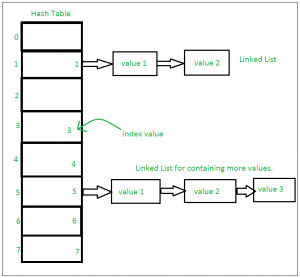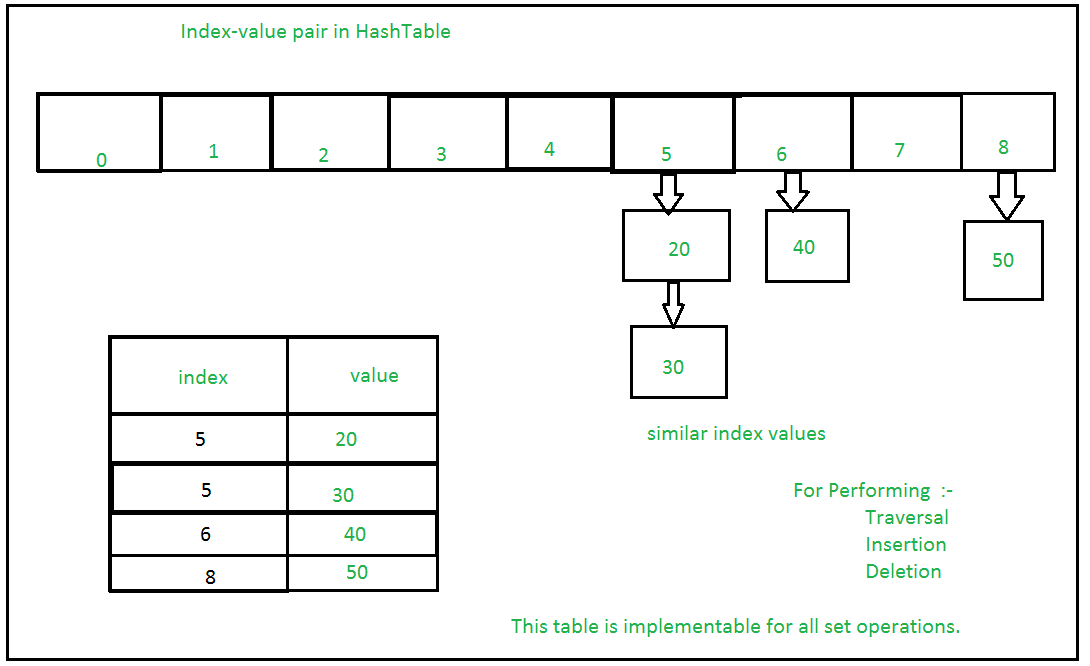Sets in Python (original) (raw)
A Set in Python is used to store a collection of items with the following properties.
- No duplicate elements. If try to insert the same item again, it overwrites previous one.
- An unordered collection. When we access all items, they are accessed without any specific order and we cannot access items using indexes as we do in lists.
- Internally use hashing that makes set efficient for search, insert and delete operations. It gives a major advantage over a list for problems with these operations.
- Mutable, meaning we can add or remove elements after their creation, the individual elements within the set cannot be changed directly.
Example of Python Sets
Python `
s = {10, 50, 20} print(s) print(type(s))
`
Output
{10, 50, 20} <class 'set'>
**Note : There is no specific order for set elements to be printed
Type Casting with Python Set method
The Python set() method is used for type casting.
Python `
typecasting list to set
s = set(["a", "b", "c"]) print(s)
Adding element to the set
s.add("d") print(s)
`
Output
{'c', 'b', 'a'} {'d', 'c', 'b', 'a'}
Check unique and Immutable with Python Set
Python sets cannot have duplicate values. While you cannot modify the individual elements directly, you can still add or remove elements from the set.
Python `
Python program to demonstrate that
a set cannot have duplicate values
and we cannot change its items
a set cannot have duplicate values
s = {"Geeks", "for", "Geeks"} print(s)
values of a set cannot be changed
s[1] = "Hello" print(s)
`
**Output:
The first code explains that the set cannot have a duplicate value. Every item in it is a unique value.
The second code generates an error because we cannot assign or change a value once the set is created. We can only add or delete items in the set.
{'Geeks', 'for'}
TypeError: 'set' object does not support item assignment
Heterogeneous Element with Python Set
Python sets can store heterogeneous elements in it, i.e., a set can store a mixture of string, integer, boolean, etc datatypes.
Python `
Python example demonstrate that a set
can store heterogeneous elements
s = {"Geeks", "for", 10, 52.7, True} print(s)
`
Output
{True, 'for', 'Geeks', 10, 52.7}
Python Frozen Sets
**Frozen sets in Python are immutable objects that only support methods and operators that produce a result without affecting the frozen set or sets to which they are applied. It can be done with frozenset() method in Python.
While elements of a set can be modified at any time, elements of the frozen set remain the same after creation.
If no parameters are passed, it returns an empty frozenset.
Python `
Python program to demonstrate differences
between normal and frozen set
Same as {"a", "b","c"}
s = set(["a", "b","c"])
print("Normal Set") print(s)
A frozen set
fs = frozenset(["e", "f", "g"])
print("\nFrozen Set") print(fs)
Uncommenting below line would cause error as
we are trying to add element to a frozen set
fs.add("h")
`
Output
Normal Set set(['a', 'c', 'b'])
Frozen Set frozenset(['e', 'g', 'f'])
Internal working of Set
This is based on a data structure known as a hash table. If Multiple values are present at the same index position, then the value is appended to that index position, to form a Linked List.
In, Python Sets are implemented using a dictionary with dummy variables, where key beings the members set with greater optimizations to the time complexity.
**Set Implementation:

Hash Table
Sets with Numerous operations on a single HashTable:

Hashing
Methods for Sets
Adding elements to Python Sets
Insertion in the set is done through the set.add() function, where an appropriate record value is created to store in the hash table. Same as checking for an item, i.e., O(1) on average. However, in worst case it can become **O(n).
Python `
A Python program to
demonstrate adding elements
in a set
Creating a Set
people = {"Jay", "Idrish", "Archi"}
print("People:", end = " ") print(people)
This will add Daxit
in the set
people.add("Daxit")
Adding elements to the
set using iterator
for i in range(1, 6): people.add(i)
print("\nSet after adding element:", end = " ") print(people)
`
Output
People: {'Idrish', 'Archi', 'Jay'}
Set after adding element: {1, 2, 3, 4, 5, 'Daxit', 'Archi', 'Jay', 'Idrish'}
Union operation on Python Sets
Two sets can be merged using union() function or | operator. Both Hash Table values are accessed and traversed with merge operation perform on them to combine the elements, at the same time duplicates are removed. The Time Complexity of this is **O(len(s1) + len(s2)) where s1 and s2 are two sets whose union needs to be done.
Python `
Python Program to
demonstrate union of
two sets
people = {"Jay", "Idrish", "Archil"} vampires = {"Karan", "Arjun"} dracula = {"Deepanshu", "Raju"}
Union using union()
function
population = people.union(vampires)
print("Union using union() function") print(population)
Union using "|"
operator
population = people|dracula
print("\nUnion using '|' operator") print(population)
`
Output
Union using union() function {'Idrish', 'Arjun', 'Jay', 'Karan', 'Archil'}
Union using '|' operator {'Idrish', 'Deepanshu', 'Raju', 'Jay', 'Archil'}
Intersection operation on Python Sets
This can be done through intersection() or & operator. Common Elements are selected. They are similar to iteration over the Hash lists and combining the same values on both the Table. Time Complexity of this is O(min(len(s1), len(s2)) where s1 and s2 are two sets whose union needs to be done.
Python `
Python program to
demonstrate intersection
of two sets
set1 = set() set2 = set()
for i in range(5): set1.add(i)
for i in range(3,9): set2.add(i)
Intersection using
intersection() function
set3 = set1.intersection(set2)
print("Intersection using intersection() function") print(set3)
Intersection using
"&" operator
set3 = set1 & set2
print("\nIntersection using '&' operator") print(set3)
`
Output
Intersection using intersection() function {3, 4}
Intersection using '&' operator {3, 4}
Finding Differences of Sets in Python
To find differences between sets. Similar to finding differences in the linked list. This is done through difference() or – operator. Time complexity of finding difference s1 – s2 is O(len(s1))
Python `
Python program to
demonstrate difference
of two sets
set1 = set() set2 = set()
for i in range(5): set1.add(i)
for i in range(3,9): set2.add(i)
Difference of two sets
using difference() function
set3 = set1.difference(set2)
print(" Difference of two sets using difference() function") print(set3)
Difference of two sets
using '-' operator
set3 = set1 - set2
print("\nDifference of two sets using '-' operator") print(set3)
`
Output
Difference of two sets using difference() function {0, 1, 2}
Difference of two sets using '-' operator {0, 1, 2}
Clearing Python Sets
Set Clear() method empties the whole set inplace.
Python `
Python program to
demonstrate clearing
of set
set1 = {1,2,3,4,5,6}
print("Initial set") print(set1)
This method will remove
all the elements of the set
set1.clear()
print("\nSet after using clear() function") print(set1)
`
Output
Initial set {1, 2, 3, 4, 5, 6}
Set after using clear() function set()
**However, there are two major pitfalls in Python sets:
- The set doesn’t maintain elements in any particular order.
- Only instances of immutable types can be added to a Python set.
Time complexity of Sets
| Operation | Average case | Worst Case | notes |
|---|---|---|---|
| x in s | O(1) | O(n) | |
| Union s|t | O(len(s)+len(t)) | ||
| Intersection s&t | O(min(len(s), len(t)) | O(len(s) * len(t)) | replace “min” with “max” if t is not a set |
| Multiple intersection s1&s2&..&sn | (n-1)*O(l) where l is max(len(s1),..,len(sn)) | ||
| Difference s-t | O(len(s)) |
Operators for Sets
Sets and frozen sets support the following operators:
| Operators | Notes |
|---|---|
| key in s | containment check |
| key not in s | non-containment check |
| s1 == s2 | s1 is equivalent to s2 |
| s1 != s2 | s1 is not equivalent to s2 |
| s1 <= s2 | s1 is subset of s2 |
| s1 < s2 | s1 is proper subset of s2 |
| s1 >= s2 | s1 is superset of s2 |
| s1 > s2 | s1 is proper superset of s2 |
| s1 | s2 | the union of s1 and s2 |
| s1 & s2 | the intersection of s1 and s2 |
| s1 – s2 | the set of elements in s1 but not s2 |
| s1 ˆ s2 | the set of elements in precisely one of s1 or s2 |
Problems based on Set
- Distinct Elements in an Array
- Union of Two Arrays
- Intersection of Two Arrays
- Distinct Elements in an Array
- Union of Two Arrays
- Intersection of Two Arrays
- Repeating Elements
- Check if an Array is Subset of other
- Check Pair with Target Sum
- Check for Disjoint Arrays or Sets
- Duplicate within K Distance
- Longest Consecutive Sequence
- Check for Disjoint Arrays or Sets
- Duplicate within K Distance in an Array
- 2 Sum – Check for Pair with target sum
- Longest Consecutive Sequence
- Only Repeating Element From 1 To n-1
